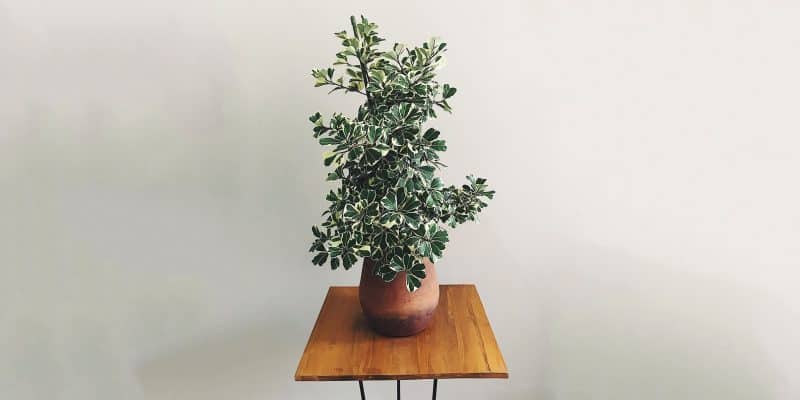If you’re looking to add another leafy friend to your home, look no further than the fabulous Ficus triangularis.
As soon as you lay eyes on the Ficus triangularis, you’ll fall in love with its unique leaves and quirky charm. The sturdy branches filled with lush, triangular-shaped leaves bring a bit of geometric whimsy into your home.
In this article, we’ll give you the lowdown on Ficus triangularis care, from watering and lighting to keeping pests away. At the end, we’ll cover the issues we see the most frequently.
Let’s grow!
Table of Contents
Ficus Triangularis Plant Care Guide
History, Habitat, and Characteristics
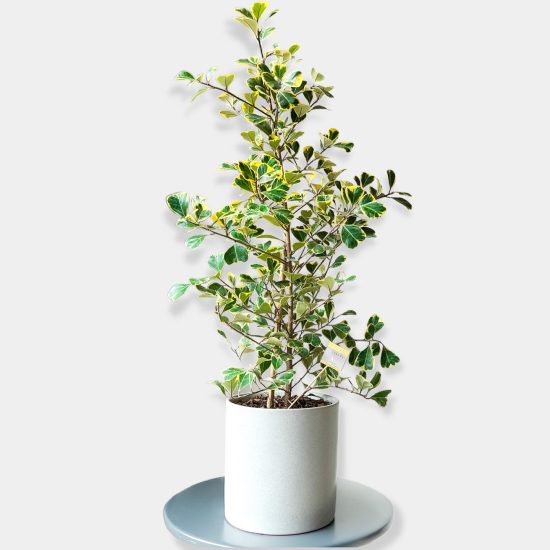
Ficus triangularis, as well as its variegated brethren, Ficus triangularis ‘Variegata,’ hails from the tropical regions of South Africa and Asia. The variegated Ficus triangularis steals the spotlight with its striking white outlines. Keep in mind, though, that the lack of chlorophyll in these white areas means it requires more light to photosynthesize and stay healthy.
Ficus triangularis is part of the Moraceae family, sharing the limelight with popular plants like the weeping fig (Ficus benjamina) and the fiddle-leaf fig (Ficus lyrata). Each of these tree-type ficuses grows quite large. Your Ficus triangularis, under the right conditions, could grow as tall as 8 feet!
(Ficus triangularis ‘Variegata’ care is basically the same, so we’ll be covering both below!)
Light
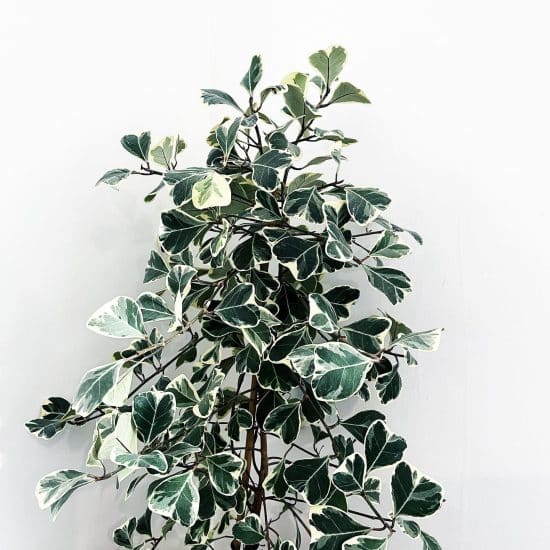
Ficus triangularis has some specific lighting requirements to flourish indoors. These ficus plants need a bit more sunlight compared to other indoor plants. They appreciate a south-facing window where they can bask in direct sunlight. A west-facing window will do in a pinch.
If your Ficus triangularis isn’t getting enough light, you may notice slow growth and leaves that reach out for any available light source, as if trying to give the sun a big hug. When this happens, it’s time to ramp up the sunlight!
Even though Ficus triangularis likes a bit of direct sun, monitor it for leaf burn. Excessive direct sunlight can lead to scorched or burned leaves that lose their once-vibrant colors and become faded, brown, or even brittle.
If your plant is suffering from too much sun, you can always give it some shade by adding a sheer curtain or moving it a few feet away from the window.
Our light tips:
- Bright light is best for these sun lovers.
- South- and west-facing windows will provide the best lighting conditions.
- Variegated Ficus triangularis craves even more sunlight than the green-leaf variety.
- During the warm growing season, you can treat your plant to some outdoor exposure with gentle morning sunlight.
Water
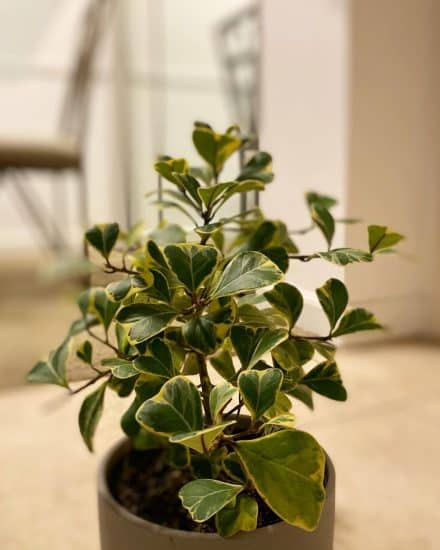
This houseplant prefers its soil to dry out slightly between waterings. The best way is to feel the soil with your finger. Naturally, your ficus will want more water during the hot days of its summer growing season and far less in the winter.
If your Ficus triangularis isn’t getting enough water, you’ll notice a few telltale signs. Wilting leaves, leaf curling, and dry or crispy leaf edges may befall your plant, hinting that it’s time to increase your watering frequency.
On the flip side, too much water can lead to yellowing leaves, mushy stems, and soil that just won’t dry out — a clear indication that it’s time to cut back on the watering and give those plant roots a chance to breathe.
Our water tips:
- Feel the soil an inch or two beneath the surface to check the moisture level. If it’s dry but not parched, give your Ficus triangularis a drink, but don’t overdo it.
- Adjust your watering schedule according to the season and indoor conditions.
- To avoid waterlogged plant roots, make sure your pot has proper drainage holes.
Temperature and Humidity
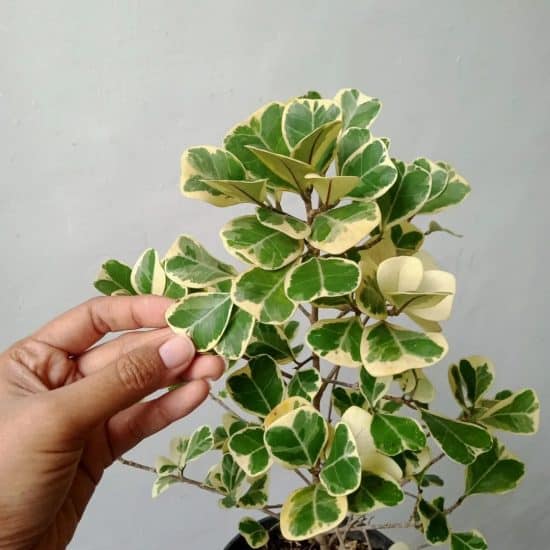
Caring for your Ficus triangularis, also known as the triangle fig or sweetheart tree, requires attention to both temperature and humidity levels in its environment.
Normal household temperatures are generally fine for Ficus triangularis. Ideally, aim to keep your green friend in a comfortable range of 60-80°F (20-28°C).
To ensure the temperature is just right, steer clear of drafty windows and doors in winter. It’s also a good idea to watch how close you place your ficus to air conditioning and heating vents, which can affect its foliage too.
Keep an eye out for signs of temperature stress in your plant. If you notice leaves curling, yellowing, or stunted growth, your Ficus triangularis might be throwing you a subtle hint that it’s too cold. On the other hand, wilting or scorched leaves could mean it’s way too hot in there.
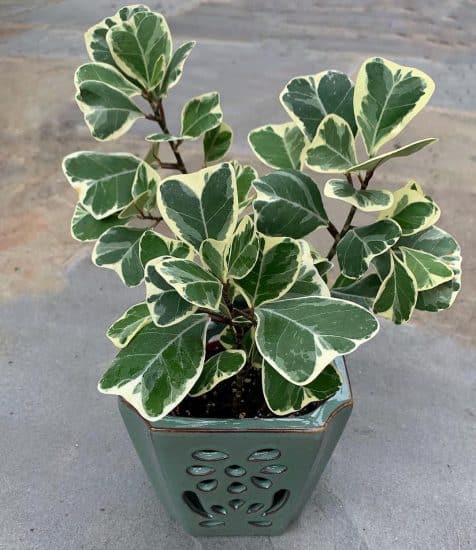
Humidity is equally important for your Ficus triangularis. This tropical plant might hang in there with medium to lower humidity levels, but it truly thrives in balanced conditions. A moderate humidity level between 40% and 60% should serve your ficus plant well.
If your plant’s leaves start looking dry, lose their shine, or get brown edges, it might be time to up the humidity game. Conversely, if you see moldy or mushy leaves, the humidity could be a bit excessive.
To increase humidity, place your plant on a drip tray filled with water and pebbles and keep the tray well hydrated. As the water evaporates, it will raise the humidity around your plant. If that’s not an option (it can be difficult with large plants), add a humidifier nearby and run it for a few hours each day.
Soil and Planting
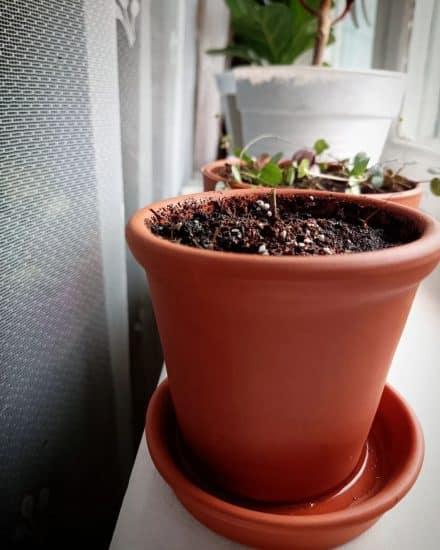
The Ficus triangularis plant thrives in the right soil composition, which is crucial for its slow-growing nature and overall health.
Any well-draining potting mix will work for Ficus triangularis. To enhance drainage and aeration, add a generous helping of perlite and pine bark to the mix. Never plant a ficus in a pot without drainage.
These plants grow quickly and tall, so you’ll need to repot eventually. Avoid repotting your Ficus triangularis too often, though. Aim for about every 2 years, in spring. Expect the repotting process to become more difficult as the plant ages and grows bigger.
Fertilizing
During the growing season, it’s essential to provide your Ficus triangularis with the nutrients it craves. Opt for a balanced granular fertilizer (like Miracle-Gro’s 20-20-20 formula) or liquid houseplant fertilizer, but play it safe by cutting the dosage in half for the first few applications.
Be vigilant for signs of over-fertilization, such as yellowing leaves, brown tips, or stunted growth. Spotted any of these symptoms? Simply flush the soil with water to dilute the excess fertilizer, and remember to reduce the amount used in future applications.
Propagation
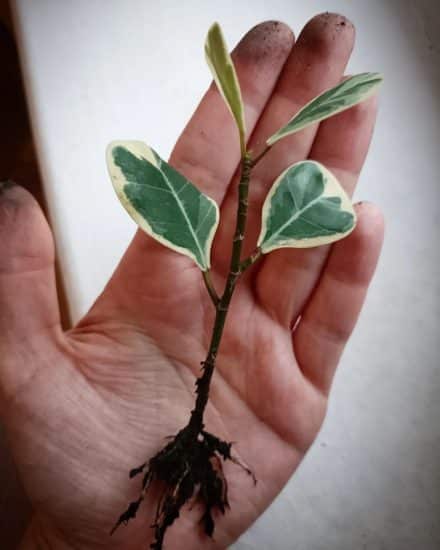
Propagating Ficus triangularis is a great way to grow more plants and enjoy the process of nurturing new life. Follow these easy steps to propagate your Ficus triangularis or Ficus triangularis ‘Variegata’ plant using stem cuttings:
- Pick out a healthy Ficus triangularis branch with plenty of green leaves and locate the nodes along the stem, where branches and its triangle-shaped leaves form.
- Snip a section between two nodes with clean, sterile pruning shears.
- Pop the cutting into a container filled with a dry mix of perlite and coconut coir.
- Keep the rooting medium damp but not soaking wet and keep an eye on your cutting’s progress.
- When roots have formed, transfer the cutting to a small pot with well-draining soil and adequate drainage holes.
- Water your newly potted cutting, letting it drain from the bottom. Avoid letting the soil and roots sit in water.
- Place your potted cutting in a humid environment to help it adjust to the soil, and give it bright light.
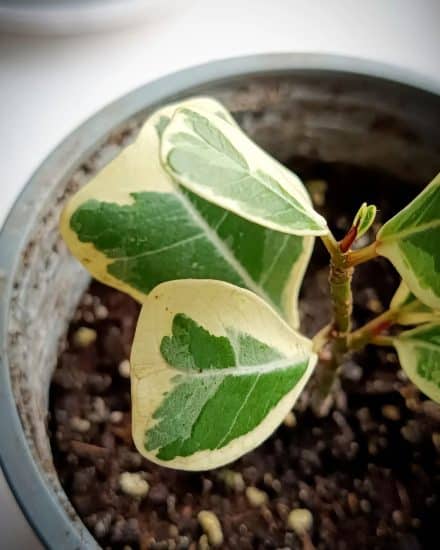
Our propagation tips:
- You can use water to propagate your triangle ficus — just know there’s a good chance the woody stem will rot before a root system forms.
- If you’re adventurous, look into air layering as an alternative propagation method.
Common Issues
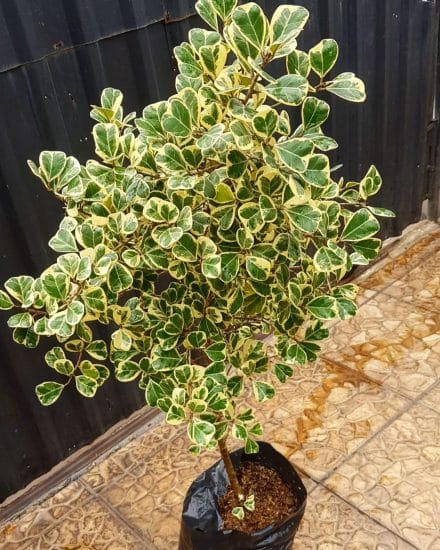
Ficus triangularis, a resilient member of the Ficus genus, can still face some common issues from time to time.
Dropping Leaves
Although falling leaves may initially worry Ficus triangularis owners, remember that this can be a natural response to changes in the environment or plant aging. To determine if there’s an underlying issue, observe your plant’s overall health and note any recent changes in the environment.
Excessive leaf dropping may be a result of overwatering, low temperature, not enough light, or too much fertilizer. Ensure your Ficus triangularis gets bright light, and water it moderately when the top few inches of soil feel dry. Fertilize with care and maintain a moderate temperature throughout the year.
Pests and Diseases
In this section, we’ll discuss how to identify and tackle the most common issues your ficus may encounter, like spider mites, mealybugs, and root rot.
Spider Mites and Mealybugs
Your ficus tree can occasionally be troubled by common pests like spider mites and mealybugs. Spider mites create webbings on leaves and stems, while mealybugs appear as tiny cotton balls.
First, isolate the affected plant to protect your other plants from infestation. Thoroughly rinse your ficus to remove any visible bugs, and then use a mixture of rubbing alcohol and soap to clean the areas with signs of infestation. Make sure to apply the solution to both sides of the green leaves for maximum effectiveness.
When dealing with mealybugs, water is your best friend. You can take your Ficus triangularis ‘Variegata’ outside and hose it down with water. Mites really dislike water. Afterwards, you’ll apply neem oil every few weeks until you disrupt their reproductive cycle.
Root Rot
Root rot is often caused by excessive moisture in the soil, as well as a lack of adequate drainage holes, which encourages harmful fungi to grow.
To spot it, look for wilting leaves, mushy stems, and a funky smell coming from your plant. If you find these signs, it’s time to take action! Remove your plant from its pot and use sterilized scissors to trim away any affected dark, slimy roots. Dispose of the old soil and thoroughly clean the pot before repotting your Ficus triangularis in fresh, well-draining soil.
If your pot doesn’t have any drainage holes, either get a new one that does or drill them yourself. All you’ll need is a drill, a diamond drill bit, and a spray bottle filled with water. Spray the area where you plan to drill your hole and keep it wet. Go slow and don’t push, or you risk breaking your pot.
Adding perlite, pumice, or LECA (lightweight expanded clay aggregate) to your potting mix can improve aeration and drainage, preventing future rot. Water your plant sparingly, allowing the soil to dry out between waterings.
Conclusion
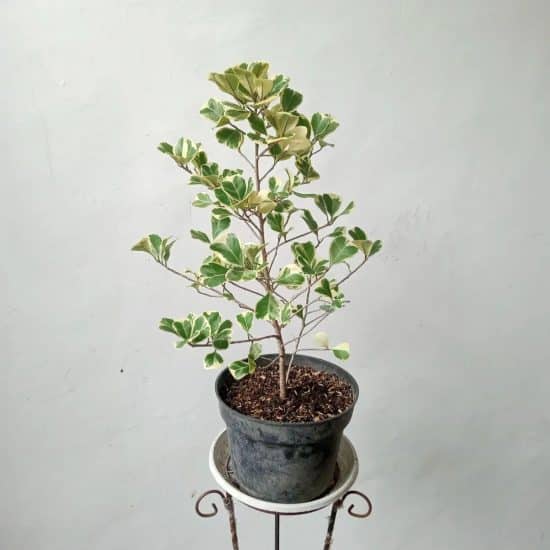
That’s a wrap for our Ficus triangularis care guide!
With its uniquely shaped leaves and stunning foliage, the Ficus triangularis is an excellent choice for any plant enthusiast seeking to add some geometric charm to their indoor garden.
Ficus triangularis care summary:
- Provide ample bright light, especially for the variegated variety, and avoid scorching the leaves with too much direct sunlight.
- Maintain consistent warm temperatures and moderate humidity levels for optimal growth.
- Ensure proper drainage and a well-draining soil mix to avoid root rot and other issues.
We genuinely hope that this guide helps you on your journey with this remarkable houseplant. If you have any questions or need further assistance, don’t hesitate to reach out. And if it’s been helpful, share it with a fellow plant lover!
Take care, and happy planting!
FAQ
Is Ficus triangularis an indoor or outdoor plant?
While this versatile plant can thrive in both settings, it’s most commonly kept as an indoor houseplant. When grown indoors, the Ficus triangularis loves lots of bright light and a stable environment.
However, if you want to let your plant bask in some fresh air, it can certainly do well outdoors in warmer months, as long as you protect it from intense sunlight or dramatic temperature changes. Just remember to bring it back inside as the weather cools to keep it happy and healthy.
Why is my Ficus triangularis dropping leaves?
The most common reason for leaf drop is improper watering, usually too much but sometimes too little as well. Check for signs like yellowing leaves, wilting, or dry leaf edges to determine the proper watering adjustment.
Another potential cause could be a sudden change in temperature or humidity. Ensure that your plant has a comfortable, stable environment, and it should regain its lush appearance in no time.
Is Ficus triangularis easy to care for?
For the most part, Ficus triangularis is a low-maintenance and beginner-friendly houseplant. Thanks to its vibrant, unique foliage and relatively easy-going nature, it’s a popular choice for indoor plant enthusiasts.
While it might be more particular about its moisture levels compared to some of its ficus relatives, as long as you maintain slightly damp soil and provide plenty of bright light, you’ll be rewarded with a thriving, stunning plant that’s sure to impress.
Should you care for Ficus triangularis ‘Variegata’ differently than other Ficus plants?
Despite its unique appearance, its care requirements are actually quite similar to the regular Ficus triangularis. However, there’s one critical aspect to pay extra attention to — light.
Variegated plants need more sunlight to maintain their beautiful colors, so ensure that your Ficus triangularis ‘Variegata’ gets ample bright light. As long as you maintain the right watering, light, and environmental conditions, your variegated plant will continue to dazzle with its gorgeous foliage.

